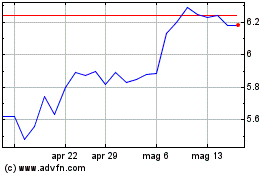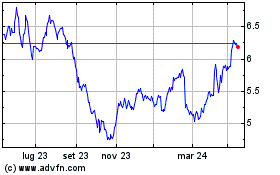By Trefor Moss
HONG KONG -- Airlines around the world are counting the cost of
the coronavirus that has led to thousands of China flights being
canceled, with several Asian airlines teetering on the brink of
ruin if the nation's shutdown persists.
Many carriers have taken emergency measures in hope of
offsetting expected losses resulting from the continuing slump in
global traffic. In Hong Kong, Cathay Pacific Airways Ltd. --
already feeling the impact of the city's antigovernment protests --
has asked all its staff to take three weeks' unpaid leave, while
Hong Kong Airlines Ltd. has sacked more than 400 workers. Asiana
Airlines Inc., South Korea's second largest carrier, also asked
thousands of staff to take unpaid leave.
Even flights not passing through China have been axed from
schedules. Australia's Qantas Airways Ltd. said Thursday it was
reducing services to Hong Kong and Singapore in addition to
suspending flights to China until at least the end of May, while
Thai Airways International PCL has cut flights connecting Bangkok
with Seoul and Singapore, as regional customers lose their appetite
for travel.
China's rise to the world's second busiest aviation market after
the U.S. has been a strong source of growth for all the world's
major airlines, which have expanded direct services to Chinese
destinations in recent years, some offering dozens of flights a
week. American Airlines Group Inc.'s American Airlines, for
example, normally operates 28 weekly flights between the U.S. and
China.
But that has left them badly exposed to major disruption in
China. As the epidemic worsened, many foreign airlines, including
the major U.S. carriers, completely halted flights to Chinese
destinations last month.
China's own airlines have become some of the world's biggest,
establishing a global footprint. All have slashed services over the
past month as the country battles the epidemic, which by Wednesday
had infected 74,576 and killed 2,118 people in mainland China,
according to the official count.
With millions of Chinese people facing travel restrictions and
many others simply avoiding nonessential travel, regional demand
for flights has collapsed, forcing carriers to cancel over 25,000
flights a week in total, according to aviation data company
OAG.
The number of seats available on domestic Chinese flights fell
63% year-over-year to 5.4 million in the second week of February,
OAG said. And many of those seats were empty, with daily passenger
numbers down 91% on year as of Monday, according to the Civil
Aviation Administration of China.
"No event that we remember has had such a devastating effect on
capacity, " OAG's senior analyst John Grant wrote in a Feb. 17
commentary. While the SARS outbreak of 2003 also hit aviation
companies hard, the Chinese air-travel sector has since grown
10-fold, making the coronavirus a critical issue even for airlines
based outside Asia.
The airline industry stands to lose $5 billion in revenues in
the first quarter, the International Civil Aviation Organization
estimates. As of Feb. 14 Chinese airlines had refunded over $2.85
billion to passengers unable to take canceled flights, according to
the CAAC.
While China's big three state-run carriers -- Air China Ltd.,
China Eastern Airlines Corp. and China Southern Airlines Co. -- are
strong financially, some smaller players will struggle to sustain
the crippling of their operations for long, said Paul Yong, an
analyst at DBS Bank in Singapore.
Hainan Airlines is especially vulnerable, he said, thanks to the
well-publicized debt struggles of its parent, HNA Group Co. The
government could take the crisis as its cue to intervene and allow
the big three to carve up Hainan Airlines' routes -- a move that
was the subject of industry rumors long before the coronavirus
epidemic began.
Earlier this month Hong Kong Airlines, another HNA unit, said it
would sack at least 400 of its 3,500 employees and ask others to
take unpaid leave as it struggles to weather the crisis. On
Wednesday it said it would ax all in-flight services in a further
cost-cutting measure. Hainan Airlines and Hong Kong Airlines didn't
respond to questions.
The region's low-cost carriers are also vulnerable to prolonged
disruption, aviation analysts say.
"It becomes a question of who has the strongest balance sheets,"
said Mr. Yong. "We could potentially see some smaller players going
bankrupt."
Thailand's Nok Air, a budget carrier that has grown partly off
the back of a boom in Chinese people holidaying in Thailand, is one
that looks shaky, he said; 10 of Nok Air's 19 overseas destinations
are cities in China.
VietJet is another Asian low-cost carrier heavily dependent on
Chinese travelers: 10 of the 20 destinations it serves outside
Vietnam are Chinese.
The number of flights from China to Thailand and Vietnam were
down 60% and 84% respectively in the second week of February
compared with last year, according to OAG. Nok Air and VietJet
didn't respond to questions.
Larger carriers have also been scrambling to insulate themselves
against the continuing slump in Chinese traffic. Cathay Pacific
Airways has asked all its staff to take three weeks' unpaid leave
for the rest of 2020, after the airline cut 90% of its flights to
the mainland, accounting for roughly a third of its total
capacity.
Cathay Pacific was already reeling from a backlash among Chinese
customers over its perceived support for the protests in Hong Kong.
That led to a slump in the airline's China business and to the
resignations last year of its chairman and chief executive.
Asiana Airlines said Tuesday that it was asking thousands of
staff to take unpaid leave after it was forced to reduce its China
services by over 70%. The airline, which lost $562 million in 2019,
faces "a crisis of a massive operating loss this year" thanks to
the epidemic, the Yonhap news agency quoted Chief Executive Han
Chang-soo as saying.
Yin Yijun contributed to this article.
Write to Trefor Moss at Trefor.Moss@wsj.com
(END) Dow Jones Newswires
February 20, 2020 11:26 ET (16:26 GMT)
Copyright (c) 2020 Dow Jones & Company, Inc.
Grafico Azioni Qantas Airways (ASX:QAN)
Storico
Da Dic 2024 a Gen 2025

Grafico Azioni Qantas Airways (ASX:QAN)
Storico
Da Gen 2024 a Gen 2025
